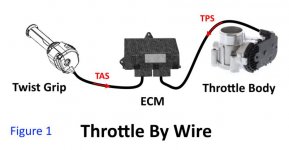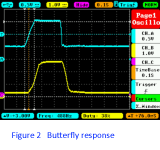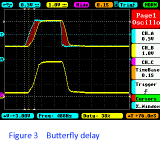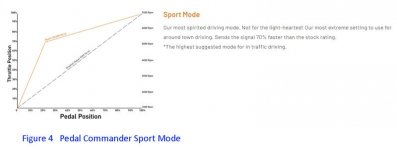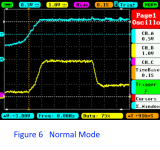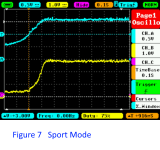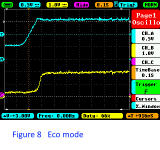Pedal Commander increases (or decreases) twist grip
sensitivity, it does not increase throttle
response.
Throttle response is a measure of how quickly a vehicle's engine can increase its power output in response to a driver's request for acceleration. Or, as Pedal Commander puts it on their website:
“…throttle response is more appropriately referred to as the time speed of increase in levels of power…”
Simply put, time to power.
Note that nowhere in the definition of “throttle response” is there any reference to the amount of effort or the distance required to move an input device to increase power. That is sensitivity.
A key factor in throttle response is how fast the Engine Control Unit (ECU) and electronic throttle body open the butterfly valve. Can add-on electronics like Pedal Commander improve throttle response?
I made throttle response measurements on my 2019 Ryker Rally, explained in detail below.
In the Ryker (and Spyder) throttle-by-wire system (Figure 1), the twist grip sends a Throttle Accelerator Signal (TAS) to the Engine Control Module (ECM, Can Am's term for ECU). The ECM controls a motor in the Throttle Body that operates the throttle butterfly valve. The Throttle Body sends a Throttle Position Signal (TPS) back to the ECM so that the ECM knows exactly the position of the butterfly valve. By monitoring the TAS and TPS, we can see the relationship between the twist grip position and movement and that of the butterfly valve, the key to throttle response. I did exactly that using an oscilloscope attached to my Ryker Rally 900.
Figure 2 shows the relationship between twist grip and butterfly valve on my Ryker powered on but not running. The blue line is the TAS and the yellow line is the TPS. The TAS varies from .5V at rest to 1.5V fully twisted, and the TPS varies from about .5V to 1.8V. To make this measurement, I twisted the grip fast, held it briefly, then let it snap back to rest. The vertical white dotted lines are measurement cursors, and the delta time is displayed at the lower right corner in orange – 76mS, or less than 1/10 second, to fully twist. This is literally faster than the blink of an eye.
In Figure 3 I've moved a copy of the TPS over the TAS, and adjusted it to the same scale vertically as the TAS. This allows us to better see the actual delay in butterfly response from twist grip, which is the red area. It is less than 50 ms (1/20th second).
Note that when I release the twist grip, it snaps back much faster than I can open it manually – almost instantly. But the butterfly does not close as fast. Why not? The butterfly is operated by an electric motor, which can only spin so fast. The motor also has to overcome inertia in the butterfly valve and the gears that connect the motor to the butterfly valve. Overcoming inertia is why the TPS takes some time to curve upward as the butterfly mechanism goes form zero to maximum speed and downward as it slows back to zero speed fully opened. When up to speed, the maximum rate at which the throttle body butterfly can operate is called the slew rate, and determines the slope of the curve. The Ryker slew rate looks to be about 60mS, which from what I understand is quite good.
If the ECM were limiting throttle response, it could only do so by limiting the speed of the butterfly below the maximum throttle body slew rate.
Can Pedal Commander increase butterfly opening speed and consequently throttle response?
To answer that, compare the slopes – the throttle body slew rates – of the leading and trailing edges of the TPS. Note that they are the same, albeit reversed of course. As noted, releasing the twist grip snaps it back faster than the slew rate of the throttle body. Also note that the slope of the leading edge of the TAS was the same as the TPS slew rate. If I could twist the grip faster, the butterfly would not open any faster, because without a Pedal Commander it is already moving as fast as is physically possible.
Pedal Commander plugs in between the twist grip and the ECM, and alters the TAS. I don't have a Pedal Commander to measure, but fortunately Pedal Commander has charts on their web site that detail operation (Figure 4).
From these charts, we see that for the same rate of twist, Pedal Commander will send a steeper slope TAS signal to the ECM, but this can and will not cause the butterfly to open any faster than the throttle body slew rate, which is already being achieved without Pedal Commander.
So, while it is technically true that throttle-by-wire exhibits a delay between grip twist and butterfly, and thus throttle response, the delay is very small. Also, the delay, and the maximum speed at which the butterfly can open, is determined by the characteristics of the throttle body motor speed and the mass of the moving parts. No electronics can make it go faster than the throttle body slew rate. We see that the Ryker ECM is not adding any delay in butterfly opening over the physical slew rate of the throttle body, but is operating it as fast as is physically possible. The ECM is not contributing to slow throttle response.
Why do many claim improved throttle response and/or acceleration with Pedal Commander? Because Pedal Commander does make the twist grip more sensitive, a small twist of the grip with it will open the butterfly more and thus deliver more power than the same small twist without it. This increase in sensitivity is perceived as improved throttle response. But we see that full butterfly opening and full power can be delivered as rapidly as the throttle body can operate without Pedal Commander by twisting more.
The Ryker ECU does limit butterfly opening under certain conditions.
I wanted to see what the butterfly was doing under different Ryker modes. These tests were done with the engine running, under real world conditions, with me fully twisting the grip from a standstill.
Figure 6 is Normal mode. You can see that the butterfly initially fully opens, but within a half second closes considerably as Traction Control takes over.
In Sport Mode, Figure 7, it stays fully open (at cost to my rear tire!).
In Eco Mode, Figure 8, note that the butterfly is limited to about 2/3 opening, which is exactly what is stated in the Ryker Operator's Guide. I expected that the ECM would also limit the butterfly slew rate, but it appears not.

